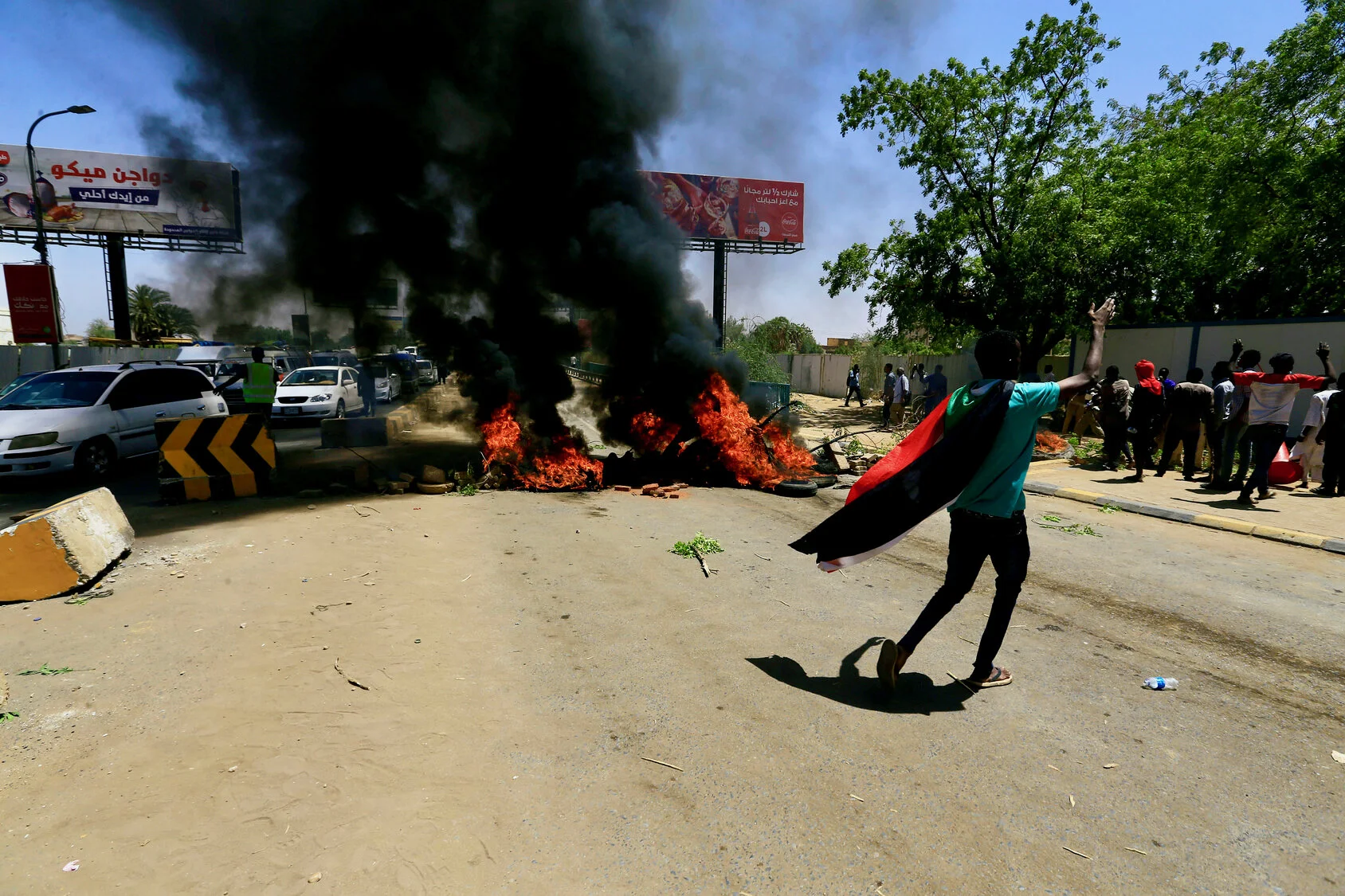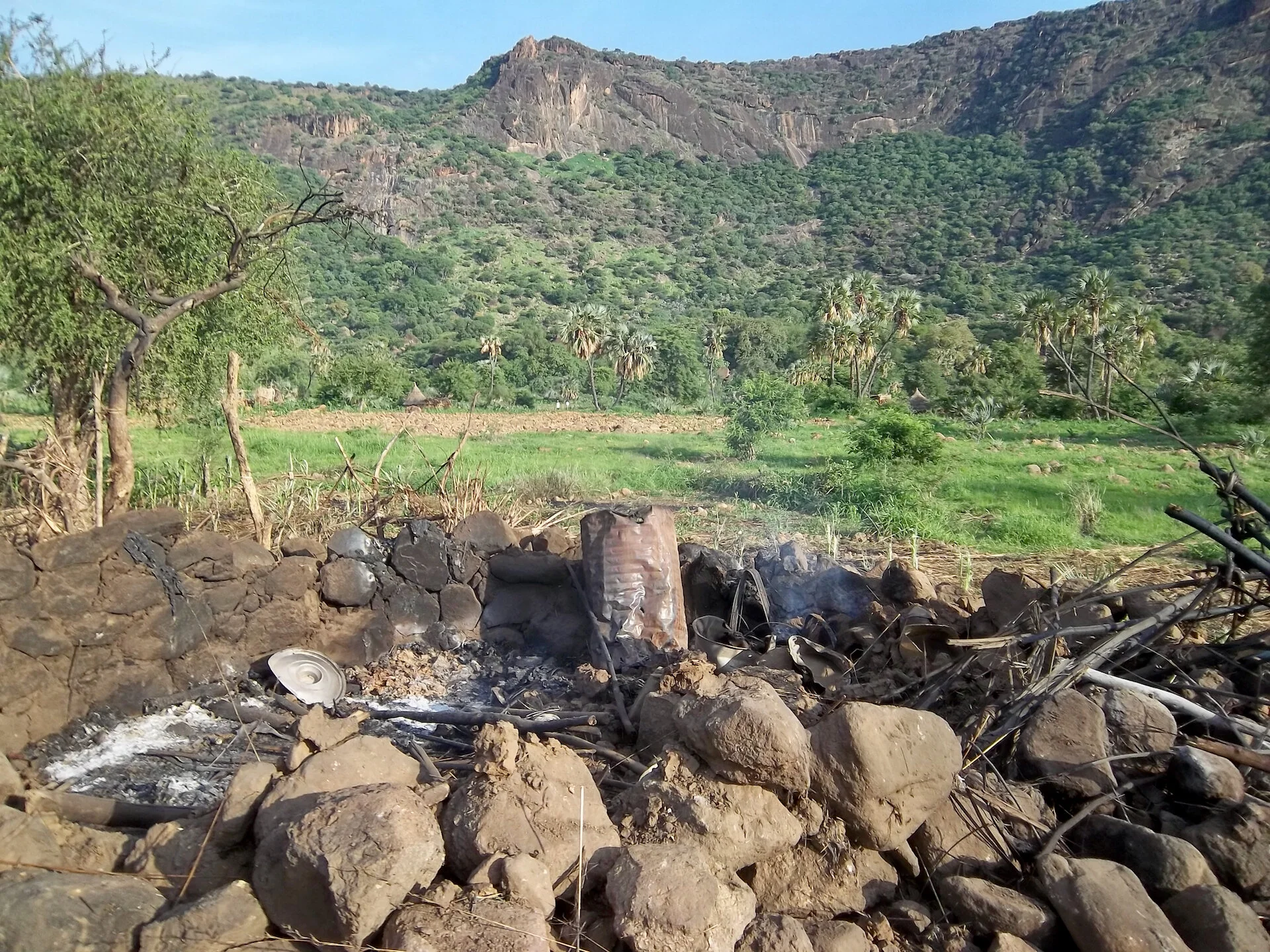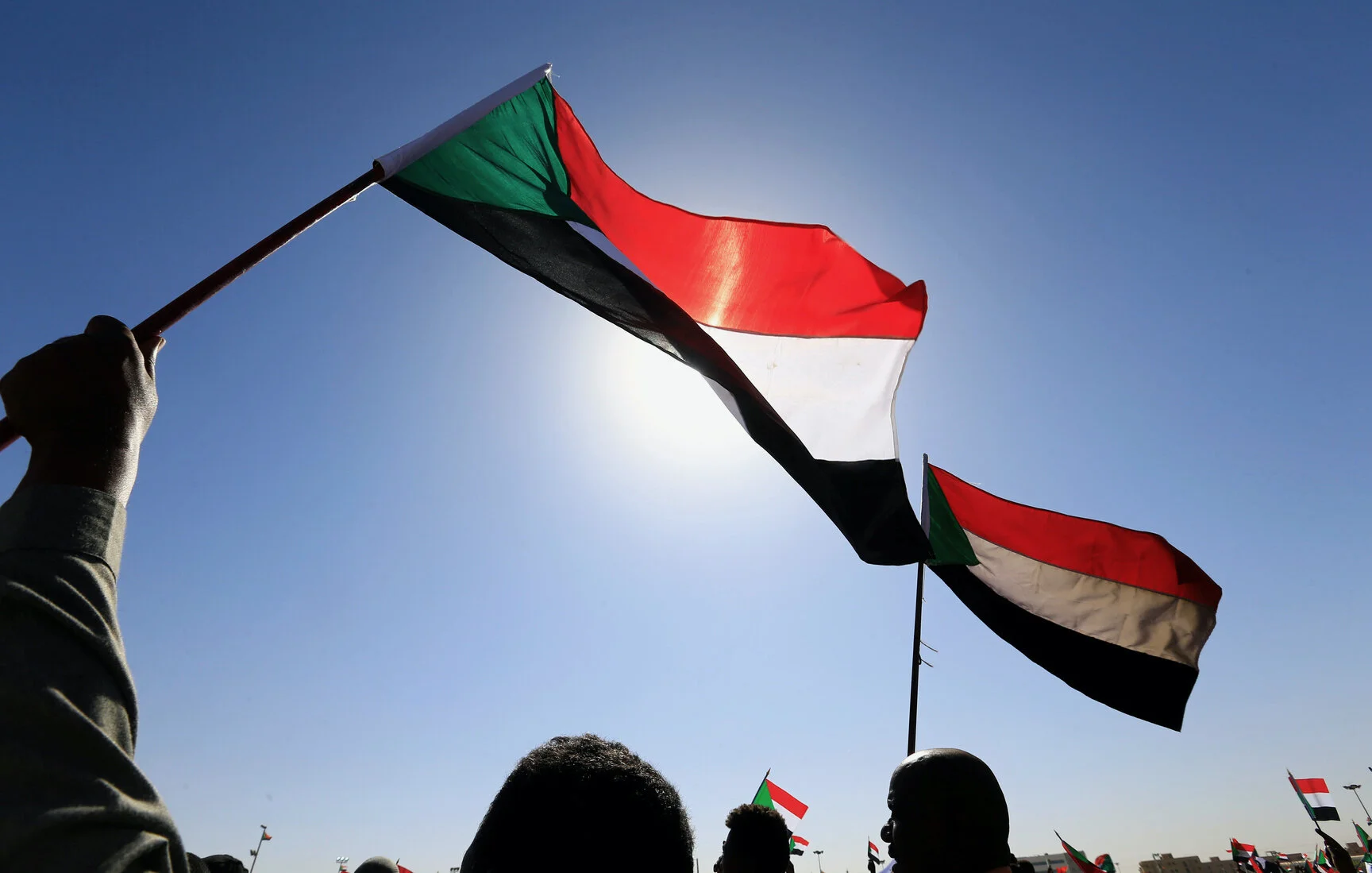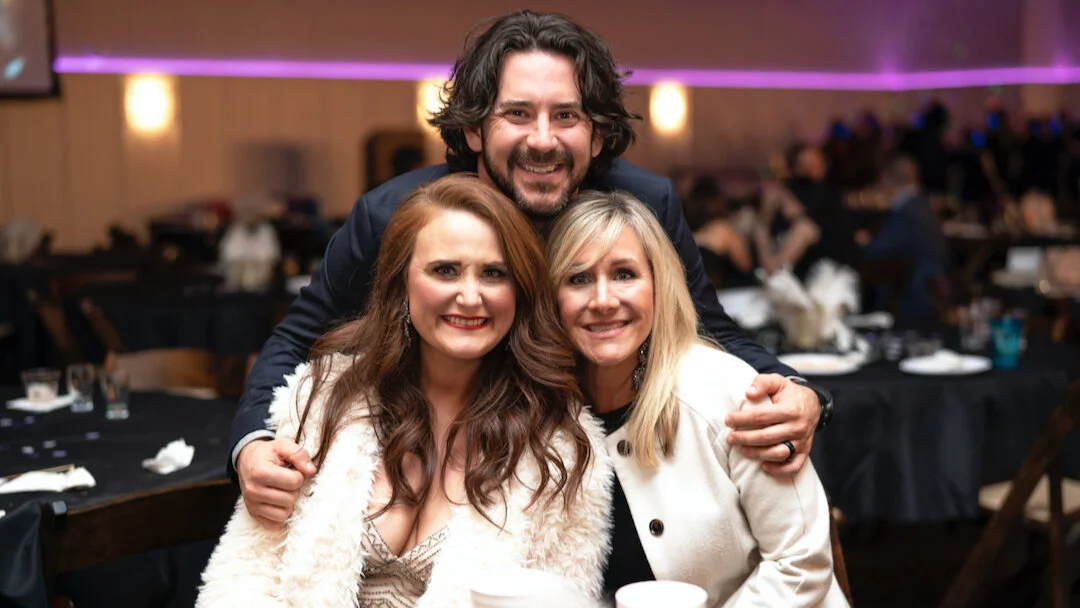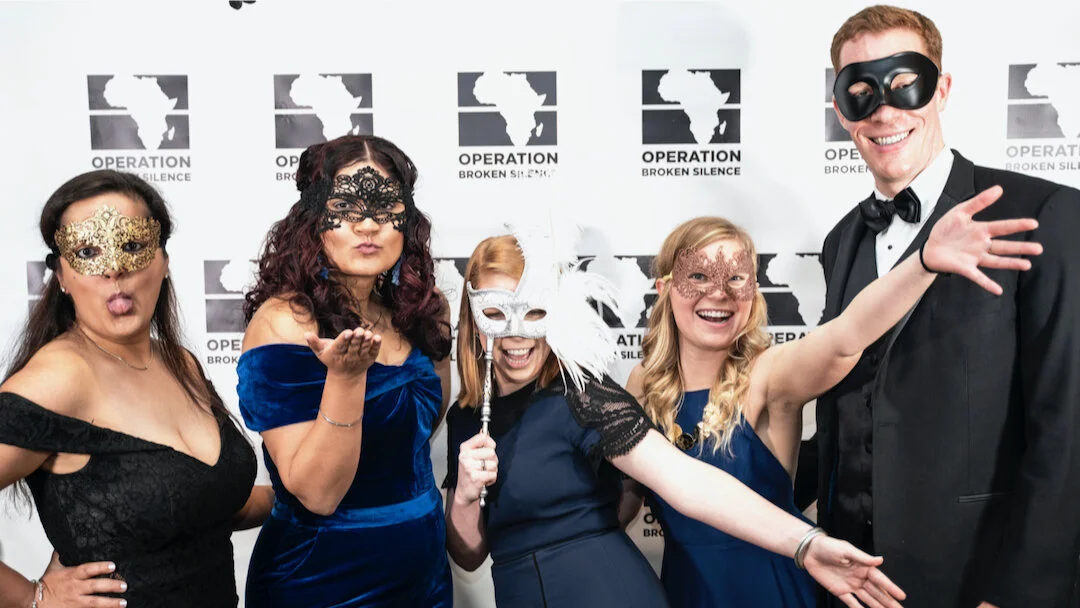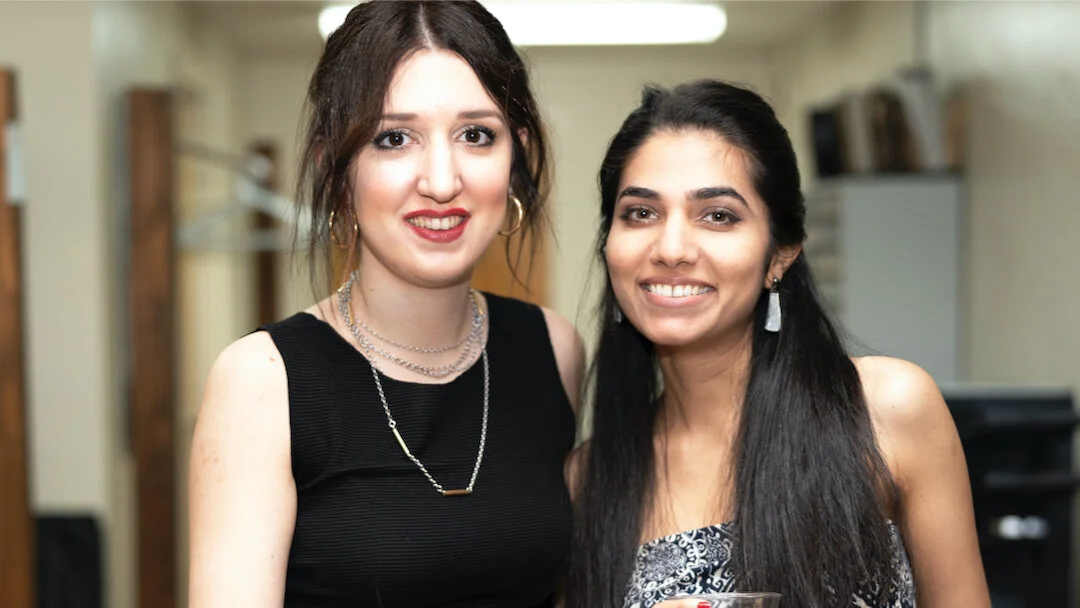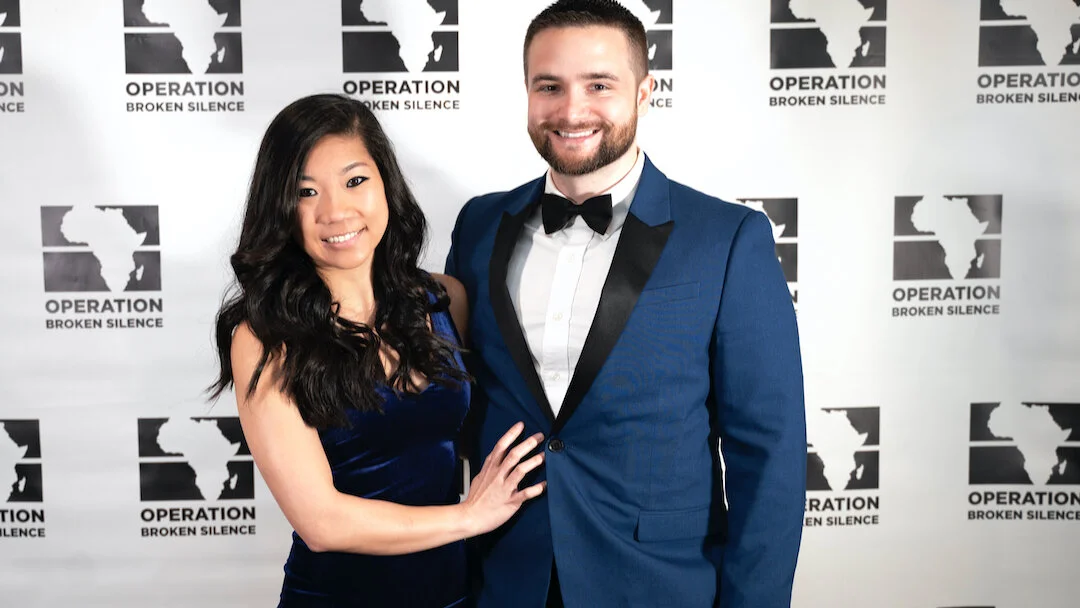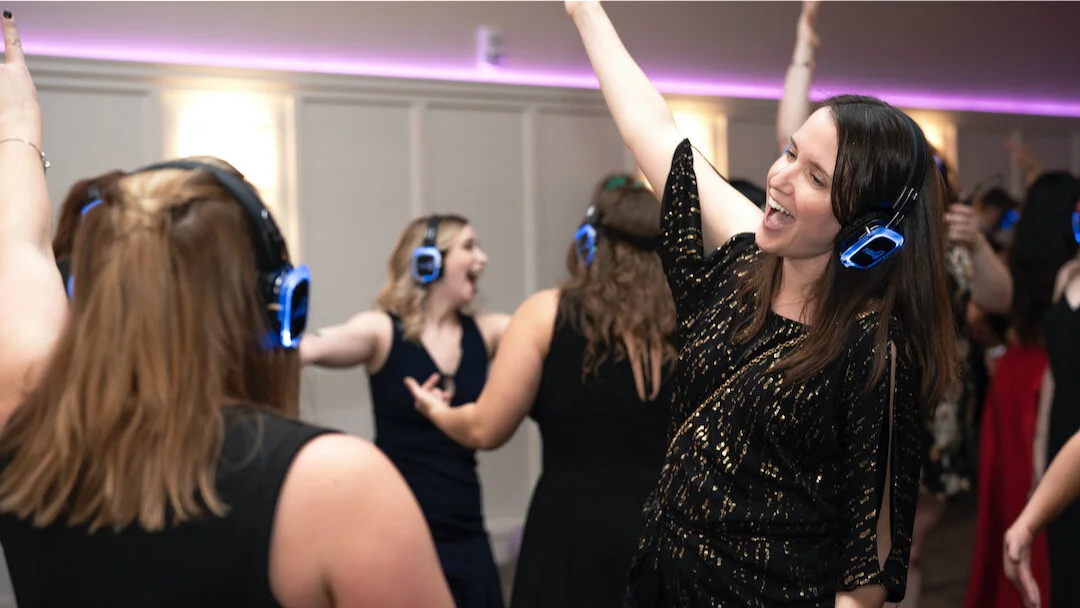News & Updates
Check out the latest from Sudan and our movement
Blue For Sudan? Learn More & Get Involved
Sudan has gone global like never before. Here’s what you need to know and how you can help.
If you are looking for answers to what is happening in Sudan and for ways to help, you've come to the right place. Read on to learn about the massacre of Sudanese protesters in Khartoum on June 3, as well as ways you can help.
On June 3, regime forces opened fire on unarmed protesters in Khartoum. Here at Operation Broken Silence, we have been warning for months that this crisis was coming. While this massacre was not unexpected, it is still unimaginably horrifying.
The military junta ruling Sudan has shut off the country’s internet. It is likely to be off for at least a few weeks. Information on what is happening on the ground in Sudan is already at a trickle. But here is what we do know.
Early on the morning of June 3, regime paramilitary units belonging to the murderous Rapid Support Forces and National Intelligence and Security Service launched an attack on the main protest encampment outside of the military headquarters in Khartoum. There are reports of mass murder, rape, and pillaging.
Only moments after the massacre began, large contingents of armed paramilitaries spread out across the capital, murdering more Sudanese civilians and placing Khartoum on lockdown. There are also reports of attacks on protesters across the entire country.
The government massacre and the #BlueForSudan hashtag has brought worldwide attention to this latest crisis unfolding in Sudan. Operation Broken Silence has been working in one of the most oppressed parts of Sudan, the Nuba Mountains, for 8 years. We come alongside of Sudanese changemakers and help them tell their own stories through film and photography. We use these stories to raise support for Sudanese-led education and healthcare programs. We focus on helping the Sudanese drive forward their solutions to their problems.
For millions of Sudanese living in the war-torn edges of Sudan, the regime massacre in Khartoum is not a new experience. It is life as usual. For some quick context into why the situation in Sudan is so bad, check out our Why Sudan? page.
If you are looking for tangible ways to support the Sudanese people right now, you’ve come to the right place. Here are specific ways to change and save lives right now in Sudan:
Operation Broken Silence sponsors the high-performing Endure Primary and new Renewal Secondary Schools in Yida Refugee Camp. We support 24 brave teachers who work here. They oversee nearly 1,200 students and orphans a day. These schools are the only stable place for children who have grown up only knowing war and genocide. Empower them to seek a brighter future:
Finally, Share This Post
We know there are a lot of other people looking for answers to what is happening in Sudan right now. After you get involved, could you share this information with your friends? Just grab the link below, share it on Facebook and Twitter and add it to your Instagram profile, and then ask people to join you.
https://www.operationbrokensilence.org/blog/blue-for-sudan-learn-more-get-involved
If you aren't sure what to write with any of your messages, feel free to copy/paste this:
Over the past few weeks, the military regime in Sudan has been committing another massacre. I'm joining the fight to directly support the Sudanese people and need you to join me: https://www.operationbrokensilence.org/blog/blue-for-sudan-learn-more-get-involved
And feel free to grab the blue photo below to share online. Unfortunately there are a number of scams online trying to get people to donate to fake things or follow them. Our friends in Sudan need our direct support now more than ever before. We need people to get involved at the right places and in the right ways. Let's roll.
Terror In Khartoum
The Sudanese regime has just committed a massacre of unarmed protesters in Khartoum. Here’s everything that we know so far.
This morning, Sudan's ruling junta committed a massacre against unarmed and peaceful protesters in Khartoum.
More details will emerge in the coming days; however, due to the sheer horror of the crimes being committed, we want to provide you with what we know and some additional context around the slaughter. Most internet in Sudan has been cut off by the junta as part of their efforts to block international coverage of the massacre. Our hope is that we can help prevent that effort from being successful.
Much of the information below has been published by other reliable sources in the past 72 hours and, in those cases, we have provided links to the original reporting. Some of what follows is newer information that has been privately reported to our organization or has not been made public in any meaningful yet.
We do warn you, the following information and images are extremely graphic and disturbing.
The Lead Up To The Massacre
Mass protests have occupied the street in front of the military headquarters since April 6, only days before Sudanese dictator Omar al-Bashir was overthrown by his own junta after nearly 30 years in power. The junta rebranded themselves as the Transitional Military Council (TMC) and promised to work with protesters to move the country toward civilian rule. That promise ended up being a colossal lie.
The junta remains fundamentally unchanged: violent, racist, and corrupt. The TMC only offered vague steps and dragged their feet in negotiations with civil society leaders. Wary protesters fed up with violent and corrupt military and Islamic rule refused to go home until their demands were met.
On Sunday, it became clear that the regime's ultimate plan had been to wait the protesters out and not cede an inch of power. TMC leaders finally lost patience. Army units quietly withdrew from the nearby streets and the main gate to their headquarters, only to be replaced moments later by the junta's genocidal Rapid Support Forces (RSF) militia. On Monday morning, the massacre began.
Hundreds of Rapid Support Forces militiamen and National Intelligence and Security Service agents marched on the sit-in protest at the army headquarters and began firing live ammunition and throwing grenades. The troops burned tents and beat the wounded and those who could not flee fast enough. Eyewitnesses reported that RSF militiamen grabbed several women and took them back to their vehicles to be raped.
A photo circulating online reportedly shows Rapid Support Forces militiamen showing off the underwear of women they raped during the attack.
The army refused to let protesters enter their headquarters or provide any sort of protection from the junta's security forces:
#SupportSudan A video showing Sudan Army land forces preventing revolutionaries from entering its premises when they tried to seek refuge from gunfire @BBCWorld @GlobalTV @The_EastAfrican @MiddleEastEye @guardian @washingtonpost @IndiaToday @AFP @TheEconomist @allafrica @Reuters pic.twitter.com/D6J37Mme4r
— SUPPORT SUDAN (@All4Sudan) June 3, 2019
Other RSF and NISS units reportedly scooped up the wounded and put them into ambulances in a failed attempt to make it look like they were trying to help. The bodies of protesters already murdered were thrown into their own vehicles. We now know that dozens of the wounded and dead bodies were taken to the Nile River nearby. RSF units killed the wounded with their firearms and machetes and mutilated the bodies of those already killed before dumping them into the river. Some bodies had stones tied to their legs so they would not rise back up to the surface.
احد الشهداء الذين تم انتشالهم من النيل ضاحية الفكي هاشم#مجزره_القياده_العامه pic.twitter.com/qvUlD8lpiY
— 🇸🇩 DiGnO #السلطة_المدنية_الانتقالية (@Digno1994) June 5, 2019
The protest site outside of the military headquarters had been a vibrant place that was full of life the past several weeks. Following the initial massacre, all that remained were torched vehicles and tents.
The former sit-in site in front of Army HQ pic.twitter.com/q6Hn8Tct47
— Cameron Hudson (@_hudsonc) June 3, 2019
There is not much video of the massacre itself yet. Most of what has made it online can be found in the Al Jazeera video at the top of this post. Protesters have been uploading endless amounts of video and photos to social media platforms for several weeks to document their stories, but the junta has cut off most internet in Sudan since the massacre. Whenever internet returns, we expect to see more video and photo evidence from the massacre emerge.
The RSF has also been robbing civilians of their cell phones across Khartoum. The RSF has a long history of violently stealing from ordinary Sudanese across the country for their own personal gain; however, this appears to be an attempt to keep protesters from getting information about junta crimes out into the world.
The RSF Spread Terror Across Khartoum
Following the initial massacre outside of the army headquarters, heavily armed RSF units chased fleeing unarmed protesters into side streets and residential neighborhoods. They were met with makeshift blockades and protesters moving vehicles into the middle of roads to block RSF movements. RSF units have continued beating, raping, and shooting protesters across Khartoum since Monday. The city has been described as "on lockdown" with RSF units killing, raping, and beating protesters and shopkeepers at will.
The Janjaweed are on the streets of Khartoum attacking civilians with live amunition
— Sudanese Translators for Change STC (@SudaneseTc) June 4, 2019
Sudan have witnessed total internet blackout since yesterday to hinder posting updates about brutal violence occuring#Internet_Blockout_in_Sudan#TMC_violations#SudanUprising pic.twitter.com/ot4vMTulE5
RSF units have also surrounded hospitals and clinics, which have been overrun with survivors and the protesters who have brought them in. RSF soldiers entered East Nile Hospital and opened fire on doctors and survivors. At Royal Care Hospital, the RSF threatened the staff and forced over 50 wounded to leave without medical care.
Yesterday, we received a private report from Khartoum that includes the names of several dozen rape survivors. Because we do not personally know the survivors and to protect their identities, we will not be releasing their names. We can say that there are several children among the survivors, including an 8 year old girl. There are at least 4 cases in which daughters and wives have been raped in front of their fathers or husbands, who were forced to watch by RSF soldiers.
The death toll has skyrocketed in recent days. As of the time of this posting, most international coverage is reporting that between 30-65 people have been killed and several hundred wounded. The private report we have received states that well over 100 people have been murdered and more than 1,000 peaceful protesters injured. Several hundred more Sudanese citizens are missing and presumed to be dead or locked up in the junta's vast network of torture chambers.
Why & How Is A Government Militia Calling The Shots
The Rapid Support Forces militia is a rebranded, better armed, and better trained version of the Janjaweed, the notorious regime militia that committed the bulk of the Darfur genocide in the 2000s. Several years ago and while Bashir was still Sudan's sitting dictator, his regime formalized the Janjaweed into a mobile and effective fighting force and spread the militia across Sudan's oppressed periphery regions. The regime dubbed the Janjaweed as the new Rapid Support Forces.
The RSF have been committing war crimes including mass murder, rape, and looting ever since. From Darfur to the Nuba Mountains to Blue Nile, RSF units have burned entire communities to the ground and battled armed rebels in the western and southern regions of the country. They have historically been mercenaries hired by the junta to decimate Sudan's already oppressed and rebellious hinterlands.
When peaceful protests against Bashir broke out in Khartoum in December 2018, the junta quietly began moving thousands of RSF units out of the besieged periphery regions of Sudan and into the capital. Where there is any form of rebellion against the regime in Sudan, the RSF usually arrives soon afterward to repress it. The Transitional Military Council restrained the RSF after seizing power from Bashir in April, but no more.
On Monday, the junta unlocked the shackles so RSF paramilitaries could do what they do best: slaughter the people and allow the military to claim they had nothing to do with the violence.
The regime has brought its genocidal wars to the capital, the very place it has long said it is fighting to protect and enrich. The RSF is unleashing its own violent culture on Sudanese who have never known it, and they seem to gleefully embrace the opportunity to show citizens in Khartoum, who have no experience with the wars and genocides of the past 30 years, what life has been like outside of the Khartoum bubble.
What Happens Next
For now, it appears that RSF commander Hemeti is trying to position himself to be Sudan's next dictator. Hemeti is technically second-in-command on the Transitional Military Council, but many Sudan observers have become immensely worried the past few weeks that he is the one pulling the strings or he is operating outside of TMC authority. Hemeti has the backing of powerful Gulf states, and the RSF has its own relations with several international actors that goes beyond official Sudanese government foreign policy.
The RSF's true size and strength is largely unknown, but Hemeti's units lack the heavy firepower of the official army, which has an array of tanks, artilllery, and more at its disposal. If there is ever a showdown between the Sudan Armed Forces and the RSF, a nightmare scenario that is increasingly likely to happen, it is highly probable that the army will enter the fray with a lot more firepower.
On the international front, the usual actors who have long supported mass murder and chaos in Sudan for their own gain are lining up behind the junta. The Russian and Chinese governments have blocked a U.N. Security Council statement condemning the violence. Saudi Arabia and the UAE are pouring money into regime coffers. And Egypt's military leaders remain opposed to civilian rule on their southern border.
The Trump Administration has mildly thrown verbal support to the protest movement; however, there is no clear policy in place. In fact, the American approach to the current crisis in Sudan can only be described as a dumpster fire. At a recent private meeting in Washington D.C, Steven Koutsis, the top ranking American diplomat in Khartoum, attempted to assuage concerns about U.S. policy toward Sudan. Attendees left with even more concerns, and much of what Koutsis said was directly contradicted by U.S. Assistant Secretary of State Johnnie Carson shortly afterward. Three other American officials have admitted the U.S. government is struggling to get basic intelligence about what is happening inside Sudan’s government and information on different political actors. Other U.S. officials have made it clear the Trump Administration has no policy on the current crisis whatsoever.
That leaves the Sudanese people themselves. While Khartoum is on lockdown due to the Transitional Military Council's Rapid Support Forces attack dog being unchained, there are early signs that this massacre is going to backfire. Protesters have been unable to reclaim their positions outside of army headquarters, but they continue to stand their ground in residential areas of the capital. Protesters have not retreated in other parts of Sudan either, despite RSF attacks.
For many Sudanese, protesting despite the immense dangers is the only option the Transitional Military Council has left them with. The junta has spent the last 30 years wrecking Sudan's economy, stealing from government coffers, shrinking public services, and committing unaffordable and pointless genocides in the name of a crazed, violent ideology that doesn't help anyone. Most Sudanese only have the breath in their lungs left to lose, especially now that the horrors of Sudan's war-torn edges have entered the capital.
Same Faces, Same Crimes, Same Regime.
With much of the world watching in awe the recent events in Sudan, we thought it would be good to provide some information from the ground that most international press is not covering.
Over the past several months, the international spotlight has returned to Sudan due to popular protests that have swept across the country and overthrown a small number of high-ranking regime officials. As a nonprofit organization that focuses exclusively on Sudan, we welcome the renewed global interest in the challenges the Sudanese people face from the regime that still controls their country.
The world’s attention has been drawn to recent events in Khartoum, where a peaceful protest movement has placed immense pressure on the so-called Transitional Military Council to hand over power to an actual transitional civilian authority. This council of army officers seized power in a palace coup from the now imprisoned dictator Omar al-Bashir on April 11, 2019. In mid-May and following an unprovoked attack by the Council’s Rapid Support Forces militia on protesters across Khartoum, the junta and protest leaders struck a fragile deal for a three year transition to civilian rule. It remains unlikely that such a deal will pan out as the regime continues dragging its feet and launching fresh attacks on unarmed and peaceful Sudanese demanding their rights.
Unfortunately, not much has changed in the regions of Sudan that have suffered the most underneath the regime. Little to no international attention is being given to places like the Nuba Mountains, Blue Nile, and Darfur, where the Transitional Military Council has largely continued the regime’s damaging oppression in far-reaching ways.
The Nuba Mountains is where our organization supports education and medical programs that serve those Sudanese who are most in need of outside assistance. These programs are led almost entirely by the Nuba people themselves, and we have a wide range of reliable contacts there. It is our privilege to support them as they work to strengthen their community from the ground up.
Since the Transitional Military Council seized power in April, a number of worrying signs in the Nuba Mountains have appeared that prove nothing has actually changed in how the regime operates.
While much of the information below has been published by other reliable sources the past few months and weeks, some of what follows is new and recent information that, at least to our knowledge, has not been made public in any meaningful way before. Regardless, all of the recent security threats and humanitarian conditions in the Nuba Mountains outlined below should be of grave concern to any actual transitional government that emerges in Khartoum, international policymakers, humanitarians, and globally-minded citizens.
The most oppressed Sudanese can not afford for the international community to look at political developments in Khartoum within a vacuum. Regime-sponsored crimes continue to be committed in the Nuba Mountains, Blue Nile, and Darfur by forces that report to Transitional Military Council leaders. Some of these regime insiders have met with international diplomats as the face of the “new” regime and should not be trusted. The Transitional Military Council is an extension of the regime underneath Bashir. It only bears a cosmetic difference from when Bashir was in control: less familiar faces, same style of corrupt and violent individuals that came up through the regime’s ranks.
More importantly though, Sudanese in the Nuba Mountains continue to suffer at the hands of the Transitional Military Council and their murderous security forces. The oppression they face should be given equal attention to the protests and political developments in Sudan’s capital, where power has been overwhelmingly concentrated for far too long.
Background
Since 2011, Sudan’s oppressive regime has waged a brutal war against the Nuba Mountains in South Kordofan, Sudan.
At surface level, the conflict has pitted the Sudan Armed Forces (SAF), the country’s official military, against the Sudan People’s Liberation Movement-North (SPLM-N), a highly-motivated armed opposition movement that is indigenous to and in control of much of the Nuba Mountains.
But as has often been the case in Sudan, a range of other armed actors who serve the regime’s kleptocratic interests have violently targeted the SPLM-N and Nuba civilians. This includes the genocidal Rapid Support Forces (RSF), a powerful government militia responsible for a plethora of war crimes across Sudan, the terrifying National Intelligence and Security Service (NISS), and a variety of other deadly security agencies and militias (Popular Defense Forces, Abu Tira, etc.) that the regime created years ago to preserve its own power.
This war in the Nuba Mountains has witnessed many of the regime’s abuses against Sudanese citizens elsewhere: indiscriminate aerial bombing of civilian infrastructure, torchings of entire communities, brutal mass killings and rapes, and a devastating humanitarian blockade. Combined together, these disturbing actions amount to a siege warfare strategy that includes directly targeting the Nuba people while simultaneously attempting to take away their ability and resources to survive. While this crisis has often been dubbed as an attempted ethnic cleansing, it bears the hallmarks of a government-sanctioned genocide against the Nuba people.
Following a series of humiliating battlefield losses in 2016, the regime declared the first ceasefire in June of that year. This ceasefire was regularly breached by SAF and the RSF in the coming months; however, this time period did mark the beginning of a painstakingly slow decline in major fighting between regime forces and the SPLM-N. The declared ceasefire has been renewed by one side or the other ever since.
While the supposed ceasefire has led to a major reduction in fighting between regime forces and the SPLM-N, security conditions remain far from positive due to ongoing junta violence against the Nuba people, much of which is outlined below.
RSF, NISS, other paramilitary forces, and Regime-Backed "Raider" Attacks On Frontlines In Nuba Mountains, Bomber Flights Continue
Throughout the past several months, SAF units have remained in defensive deployments in South Kordofan around SPLM-N controlled Nuba Mountains. SAF has not launched a major military campaign since 2016; however, there have been no signs that the Transitional Military Council is reducing its presence of SAF troops, RSF militia, or NISS squads in the Nuba Mountains.
While this lack of large-scale fighting is positive, it is only one side of a much darker story that is being overlooked.
Since the ceasefire began in 2016, the Sudanese regime has relied on a secondary method to continue a shadow war and humanitarian blockade during the ceasefire: using its wide array of paramilitary forces and arming of local Arab tribesmen, who both attack isolated frontline areas and Nuba civilians in no-man land areas on the regime’s behalf.
This secondary strategy was one the regime perfected underneath Bashir in the mid and late 2000s in Darfur. SAF units would move into defensive postures, even as Janjaweed militias went on the offensive and wreaked destruction on frontline communities. The regime regularly declared that it had nothing to do with the Janjaweed, despite rampant evidence that the militias were being provided weapons, training, and support by the Sudanese government.
It is worth noting that the Janjaweed were never disbanded as ordered by the U.N. Security Council many years ago. Instead, the regime simply rebranded them as the Rapid Support Forces (RSF) in 2013 and spread them across much of Sudan.
During the past two years of the crisis in the Nuba Mountains, this same strategy used in Darfur has been copy/pasted into the region as part of Bashir’s iron-fisted rule. The only difference is that RSF and NISS attackers have to operate more cautiously in the Nuba Mountains than they do in Darfur, largely because SPLM-N troops have been able to stand their ground against the RSF and NISS.
To be clear, this strategy has continued largely unchanged underneath the Transitional Military Council.
There have been regular Sudanese government ceasefire violations in the Nuba Mountains for years. At the forefront of such breaches are the RSF, NISS, and what have been described as “raiders” and “criminal networks,” small groups of Sudanese from nearby Arab tribes who receive weapons from the regime and use them to attack and rob isolated Nuba of their land and livestock. The RSF, NISS, and these loosely organized raiders have continued to attack Nuba civilians systematically in frontline and isolated areas in 2019, as well as play the primary role in violently enforcing the humanitarian blockade on the region.
In March 2019 and with the end of Bashir’s iron-fisted rule approaching, the UK-based Humanitarian Aid Relief Trust (HART) released a field report that summarized such attacks against the Nuba despite the declared ceasefire and ongoing protests. HART’s report pointed to the regime continuing its policy of using a mixture of paramilitary forces and “criminal networks” to target front-line villages and isolated Nuba civilians, destroy churches, and steal crops and livestock. We have received reports that this violent activity has continued underneath the Transitional Military Council, especially in the more isolated western and northern frontline areas of the Nuba Mountains.
HART also reported that while no actual aerial bombing had occurred for two years, the regime continued to fly warplanes, specifically Antonovs, over SPLM-N controlled farming areas and population centers to prevent Nuba from returning to their homes. Our own program partners and network of trusted Nuba contacts verified such bomber flights at the time as well.
While these bomber flights have reportedly decreased since the Transitional Military Council began seizing power, we have been informed by our Nuba contacts that warplanes have been sporadically spotted along western frontline areas of the Nuba Mountains the past few weeks. No bombing has been reported, but such flights continue to disrupt the Nuba people’s ability to farm, trade, and return to their homes.
The dreaded National Intelligence and Security Service (NISS) has become even more active along the frontlines of the Nuba Mountains since the Transitional Military Council seized power. NISS agents have tightened their grip on several key roads leading into and out of SPLM-N territory and arbitrarily arrested, and sometimes executed, virtually anyone who dares to travel in such areas. The NISS began intensifying these operations several weeks ago in March while Bashir was still in power and, according to our Nuba contacts, NISS agents remain deployed across much of the western and northern frontline areas underneath the Transitional Military Council. This includes roads as far southwest as Talodi locality all the way north along the western frontlines near Kadugli, Dilling, and beyond.
Finally, the Transitional Military Council has adamently refused to lift the politically-motivated death sentences issued by the regime against some SPLM-N leaders in 2014. This places a major obstacle in the way of any future peace talks for both Nuba Mountains and Blue Nile, and serves to further show that the regime is uninterested in ceding any power to the periphery.
Humanitarian Blockade Remains In Place On Nuba Mountains
Since the palace coup on April 11, the Transitional Military Council has had ample time to lift the humanitarian blockade on SPLM-N-held Nuba Mountains. This has been one of the most devastating aspects of the regime’s war against the Nuba people and has claimed thousands of lives. The blockade has prevented desperately needed food distribution, vaccination campaigns, WASH and literacy programs, and so much more.
The blockade is a clear violation of international law and has created measles outbreaks, isolated reports of polio, malnutrition, water-borne illness, soaring illiteracy rates, and many other pressing humanitarian issues. Children have overwhelmingly borne the brunt of the blockade, with many Nuba households surviving on one meal a day, schools and clinics not being adequately supplied, and access to vaccines being extremely limited for years.
Instead of offering a good faith gesture to the Nuba people and SPLM-N by unilaterally lifting the blockade and allowing unfettered relief to flow into the Nuba Mountains, the Transitional Military Council has opted to stay the course. As mentioned above, NISS agents continue to block many roads that cross from regime to SPLM-N held areas, specifically along the western frontlines. Our program partners have confirmed that aid agencies of all stripes are still banned from working in the Nuba Mountains. The RSF and government-backed Arab tribal raiders remain engaged in violence in frontline areas.
To be clear: Nuba civilians will continue suffering and dying if the regime does not immediately lift the blockade without conditions. While protesters and western countries have done the right thing in calling for the Transitional Military Council to hand over power to a civilian authority, they have not been nearly vocal enough on the continued grim reality the Nuba people face underneath the regime’s humanitarian blockade.
Because of this reality, humanitarian conditions in SPLM-N-held Nuba Mountains are once again nearing emergency levels.The Famine Early Warning Systems Network (FEWSNET) has released its projections for food insecurity in Sudan for June-September 2019. The picture is bleak:
Underneath Bashir, the regime never budged in any meaningful way with regards to lifting humanitarian blockades in the Nuba Mountains, Blue Nile, and Darfur. The regime underneath the Transitional Military Council is now reeling underneath the pressure they face from both within and outside of Sudan for real, lasting change. That pressure forced Bashir’s overthrow, led to other cosmetic changes within the regime, and continues inching Sudan towards a real transitional government. It should now be used to lift the humanitarian blockade on the Nuba Mountains, as well as the blockades in SPLM-N-controlled Blue Nile and the besieged Jebel Marra region of Darfur.
This brings us to a specific example of why the humanitarian blockade must be lifted now, not after a political solution has been reached. Many Nuba civilians do not have the luxury of waiting for political change. This reality is most evident in the Kao-Nyaro exclave of the eastern Nuba Mountains, where tens of thousands of civilians have been besieged with no hope and barely any outside assistance for years.
Besieged Kao-Nyaro in Eastern Nuba Mountains
The far eastern region of the Nuba Mountains has been isolated for decades. This little known area is usually referred to as “Kao-Nyaro,” which are two of the larger villages. Kao-Nyaro is under control of the SPLM-N, which has kept an armed presence in the area for years to prevent communities from being annihilated by Sudanese government forces.
When the regime launched the war in 2011, the already poor security and humanitarian situation in Kao-Nyaro became dire overnight. Kao-Nyaro is surrounded to the north and east by large numbers of regime paramilitary forces and government-armed Arab tribal raiders. The areas south that lead to South Sudan and west to the SPLM-N’s main strongholds are a mostly deserted no-man’s land, where Rapid Support Forces militia and Arab tribal raiders hunt for civilians attempting to flee Kao-Nyaro.
Because of these grim realities, most villages in the no-man’s land have been abandoned for years. Residents from this area suffered government attacks and have long since fled into the Kao-Nyaro exclave, the refugee camps in South Sudan, or west into the SPLM-N’s main strongholds. What little movement that does occur between the SPLM-N strongholds and the Kao-Nyaro exclave consists almost entirely of armed SPLM-N troop movements.
To give you an idea of how bad and for how the long the situation in Kao-Nyaro has persisted, this June will mark the 6th year anniversary of “The Death March,” one of the most horrific atrocities regime forces have committed against the Nuba people. Over a grisly five day period, hundreds of starving and thirsty civilians who attempted to flee Kao-Nyaro through the southern no-man’s land were hunted by regime paramilitary forces. Along the way, 73 people were killed by starvation, thirst, or gunshots at point blank range. Over half of those killed were children. While the story of this war crime is difficult to read, it remains a powerful insight into what living conditions in Kao-Nyaro are like. You can read the account here.
The crisis in Kao-Nyaro continues to lead to shocking emergency humanitarian and security conditions including death by starvation, preventable disease, lack of movement, and executions by regime forces.
Most water pumps in the area broke down or were destroyed years ago. The wells that remain are largely contaminated due to people being forced to water livestock at wellheads because of an inability to venture out to farming and pasture land, most of which is in the no man’s land around Kao-Nyaro. People are also forced to live in close quarters with their livestock because there is little freedom of movement. This has led to even more negative health effects that would most likely not exist if Kao-Nyaro were not blockaded.
Civilians here find themselves confined to SPLM-N garrison towns. Departing the Kao-Nyaro exclave to try to access traditional farm and pasture land immediately puts one in danger of being hunted by regime militia and raiders.
With humanitarian and security conditions this deplorable, childhood education is virtually non-existent in Kao-Nyaro. Villages in the SPLM-N exclave operate rudimentary schools that offer, at best, only a few primary-level grades. For example, the school in Kao village claims to have only three out of eight primary grades, and only the Koran is actually taught in classrooms. Chalk, pencils, and other basic supplies are non-existent and no one is teaching mathematics, science, history, language skills, or any of the liberal arts disciplines at all, much less basic life skills that could help elevate the community.
To make this situation even worse, over the last few years the road from Kao-Nyaro to South Sudan has been cut off due to the conflict in South Sudan. Fighting between the Shilluk tribe and Dinka-dominated government near the border has now made it unsafe for residents from Kao-Nyaro to escape into South Sudan’s northern border towns, such as Malakal and Kodok.
Simply put, journeying into or out of Kao-Nyaro ranges from extremely difficult and dangerous to impossible depending on the degree of security threats posed. Kao-Nyaro is so isolated by regime-sponsored violence that the only outside contact the area receives is when the SPLM-N repositions soldiers and equipment between their area and the area of the Nuba Mountains under their secure control far to the west.
The above information was obtained from an international team that was in Kao-Nyaro very recently, an occurrence so rare and dangerous that such outside access only occurs once every few years at most.
Today, this brutal localized blockade on the Kao-Nyaro exclave remains in effect underneath the Transitional Military Council. There are zero signs this disturbing reality will change any time soon. An estimated 27,000 lives remain in danger in Kao-Nyaro alone.
Rampant Regime Crimes Across Nuba Mountains, Blue Nile, and Darfur
Additionally, RSF, NISS, and other regime paramilitary units remain active and routinely arrest, torture, rape, and execute civilians along frontline and anti-regime areas in the Nuba Mountains (South Kordofan), Blue Nile, and across Darfur. There have been several mass crimes committed by RSF and NISS units since the Transitional Military Council declared itself in power:
April 12: NISS agents killed 7 civilians and wounded 37 more during anti-protest operations in Zalingei, Darfur
April 17: NISS agents continued to keep 400–800 Darfuris in detention at facilities, where torture and murder are common practices.
April 19: A released Darfuri lawyer stated that NISS was still moving arrested Darfuris to the dreaded “Refrigerator” detention center in Khartoum, despite NISS previously announcing that all political prisoners were to be released.
April 21: NISS agents used live fire on peaceful protesters in Kutum, North Darfur. 10 people were shot and 2 critically injured.
April 22: NISS agents used live fire on a group of peaceful protesters in El Leri, South Kordofan and wounded 9 civilians.
April 22: RSF militiamen executed Noureldin Hammad at the El Tugula gold mine in Talodi locality, South Kordofan. Hammad was executed by being shot at point blank range.
April 28: Popular Defense Forces militiamen raped two 15 and 18 year old girls at gunpoint in Abu Kershola locality, South Kordofan.
May 1: Military intelligence agents beat, arrested, and imprisoned 15 peaceful protesters in Dilling, South Kordofan.
May 2: RSF militiamen attempted to break up a peaceful demonstration in Zalingei, Central Darfur by driving vehicles into protesters and using live fire. Two civilians were wounded.
May 3: RSF militiamen entered the El Tugula gold mine market in Talodi locality, South Kordofan and began trying to execute random civilians.
May 4: Regime security forces used excessive violence to break up a peaceful demonstration in Nyala, South Darfur. More than 20 individuals were wounded and a 17-year old boy was murdered.
It is important to note that these are only reported crimes by the RSF, NISS, and other regime paramilitary units in the most oppressed regions of the country since the Transitional Military Council staged their palace coup. Many regime attacks in these areas of Sudan go unreported as they occur in isolated areas, survivors fear retribution for speaking out, or because there are simply no surviving eyewitnesses.
Conclusions
While the Transitional Military Council has made a cosmetic effort to reach out to armed opposition movements in the oppressed periphery regions of Sudan, there are no guarantees or real signs that the regime is serious about pursuing peace or lifting humanitarian blockades.
This reality is made most evident by the fact that paramilitary forces underneath the command of Transitional Military Council leaders have not been reined in from the oppressed periphery regions of Sudan, much less reformed or disbanded as so many Sudanese are calling for. The RSF, NISS, and regime-backed raiders remain violently engaged in the Nuba Mountains and continue to enforce the blockade there. The ceasefire remains a thinly-veiled farce underneath the Transitional Military Council.
Of grave concern is the rise of the commander of the RSF within the Transitional Military Council. Lt Gen Mohamed Hamdan Dagalo, who is commonly known in Sudan as Hemeti, is now the Deputy Head of the regime, effectively making him second-in-command.
Underneath Hemeti, the RSF has become the murderous oppression machine it is today and remains largely responsible for the ongoing crimes against Sudanese civilians in Darfur, the Nuba Mountains, and Blue Nile. The simple fact that Hemeti now holds a top position in the Transitional Military Council and continues to oversee one of the most recognizable aspects of the regime is perhaps the clearest sign that the Transitional Military Council is a dangerous extension of Bashir-era governance.
This is why protesters are refusing to back down and the armed opposition has not cast their weapons aside. The regime remains fundamentally unchanged, instead choosing to pursue cosmetic changes in the hopes of buying time and waiting the Sudanese people out. But even as it does so, forces underneath the command of the Transitional Military Council continue to oppress those Sudanese who are most in need of a transition to good, democratic governance.
All international efforts to drive real, positive change in Sudan by coming alongside of the Sudanese people must begin with understanding the unchanged nature of the regime, otherwise the Transitional Military Council will remain in power. The humanitarian blockades will remain in place. There will be no peace agreements. Sudanese in the Nuba Mountains, Blue Nile, and Darfur will continue to die.
This regime is too deformed to be reformed. Only uprooting it from the ground up offers the beginning of solutions to Sudan’s challenges that so many Sudanese are rightfully seeking to address.
Now is not the time to release the minimal pressure the international community has placed on the regime. It is time to drastically amp that pressure up. The Transitional Military Council’s members need to feel that every moment they remain in power and continue oppressing ordinary Sudanese, the likelihood of their own demise will rise exponentially. The Council must be forced to begin answering to the will and immediate needs of the Sudanese people. That should not just include a rapid transition to civilian authority and eventual democracy, but to the immediate ending of the regime-created humanitarian emergencies that have continued underneath the Transitional Military Council.
Staying The Course
This morning, Sudanese dictator and indicted war criminal Omar al-Bashir was informed by the heads of his own brutal security agencies that he was no longer the leader of Sudan.
This morning, Sudanese dictator and indicted war criminal Omar al-Bashir was informed by the heads of his own brutal security agencies that he was no longer the leader of Sudan.
The coup that immediately followed witnessed a number of stunning moments that many Sudanese and outside observers thought would never be seen. Army soldiers began arresting regime officials, troops stormed the Islamic Movement's headquarters, and protesters rightfully began to celebrate that the dictator had finally fallen.
And then the army announced that the protesters demands would not be met. The Sudanese people are once again being denied the transitional civilian government they demanded. Most regime officials remain in power. The coup has essentially moved one group of war criminals out of top regime leadership and replaced them with another batch.
Sudanese Defense Minister Ibn Auf, who is sanctioned by the United States over the Darfur genocide, stated that he would be taking power on behalf of the Supreme Security Committee. He is a powerful regime insider, not a reformer. Because of that reality, he has now also been pushed out of power as protests continue to mount.
His successor Lt. Gen. Abdel Fattah al-Burhan was the general inspector of the armed forces. He has also overseen the use of Darfuri child soldiers in Yemen and was an active particpant in the Darfur genocide that the Sudanese regime waged in western Sudan. Like nearly every other regime official, his hands are soaked in blood.
The military's stated plan is for the junta, now chaired by al-Buhran, to run Sudan for two years as part of a transitional process. Considering that much of this bloodthirsty regime remains intact, that promise will most likely not pan out. I certainly hope I am wrong, but al-Buhran's track record and those of the rest of the junta are not promising.
Where We Go From Here
We expect to see protests continue in the coming days and weeks. The palace coup was meant to relieve the tremendous, historic, and mounting public pressure on the regime, but so far the coup plotters have not achieved that goal. At all. Brave and peaceful protesters are refusing to stand down, and it is still unclear how far the regime's new top brass will go to retain their grip on power.
And there are no signs that the recent leadership changes in the regime mean peace and justice will come to the most oppressed and violated regions of Sudan. That includes the Nuba Mountains, where much of our focus as an organization and movement is.
Our commitment as a movement to our Sudanese partners is needed now more than ever before. Sudan is in uncharted territory. The students and teachers at the Endure Primary and Renewal High Schools in Yida Refugee Camp still need our support. Our mission remains as crystal clear as ever before: empower the Sudanese directly, and then get out of their way.
That is where we go from here. Join me to that end:
From The Ground: Sudan Uprising
See what protests in Sudan look like from the ground.
Widespread protests that erupted in Sudan on December 19 over worsening economic conditions have morphed into calls for the kleptocratic and murderous Bashir regime to be removed from power. Sudan's dictatorship has responded by unleashing its genocidal militias, National Intelligence "ghost troops," and heavily-armed police against unarmed protesters. The deadly use of live fire and tear gas by government forces against Sudanese citizens is widespread and worsening.
Over the past few days, the situation in Khartoum has grown increasingly tense. Some army units have refused to obey orders and, in a few cases, forcibly stepped in to protect protesters from Bashir's brutal security forces. There are rumors that the regime has begun arresting some mid and lower-level army officers for refusing to attack unarmed protesters. Between the mass and relentless protests, widening fissures within the government and various security forces, and a floundering international response, the situation is now changing hourly with no clear end in sight. Since Saturday, 22 Sudanese have lost their lives due to government violence.
In an attempt to cover up its crimes against Sudanese demanding their basic rights, as well as prevent protesters from better organizing, the Bashir regime has attempted to block access to social media sites. Tech-savvy Sudanese citizens have responded by using VPNs to get their stories out into the world. Below are some of their videos, photos, and stories they have shared online. We warn you that some of the images are disturbing and difficult to look at:
#SupportSudan
— SUPPORT SUDAN (@All4Sudan) April 8, 2019
The army isprotecting the 3rd day of sit-in in front of army HQ against the regime’s shadow forces.
Any talk now about political reforms is equal to support the crimes of this bloody regime @EU_Commission @NickKristof @PeterVerney1 @sudanreeves @cnni @FCOIrfan pic.twitter.com/AKs35W9WQq
#SupportSudan
— SUPPORT SUDAN (@All4Sudan) April 9, 2019
A doctor covering, with the flag of Sudan, the corpse of an unrecognised martyr who was shot dead by the regime security forces at the Armed Forces Headquarters sit-in, April 8th The doctor is crying and praying for him. @cnni @BBCWorld @GUARDIAN @AlHadath @nytimes pic.twitter.com/L7wfPb99tv
The massive sit-in taking place at the Army Headquarters in Khartoum.#SudanUprising pic.twitter.com/nVyq9U5pl1
— Sudanese Translators for Change STC (@SudaneseTc) April 9, 2019
Directly from the intensive care unit to the mass sit-in protest yard. #Sudan_Uprising. @sumodar @sudanreeves @nytimes pic.twitter.com/WCpTFbN9BJ
— Drar Adam Drar (@draradam1) April 9, 2019
A speech by soldiers from the Army Forces to the protestors at vicinity of their Headquarters where the massive sit-in is held.
— Sudanese Translators for Change STC (@SudaneseTc) April 9, 2019
They are stating that they have disobeyed orders to protect the protestors and will keep doing so until the regime falls. #SudanUprising pic.twitter.com/k6c2YsMxu9
Video from Burri tunnel April 9th، 7:30pm
— dalliasd (@dalliasd) April 9, 2019
فيديو من فوق النفق ٩ ابريل، ٧.٣٠ مساء
Video from @haysabun #SudanUprising #موكب_٩_ابريل pic.twitter.com/LyxeXsq0bM
#Sudanese #Christians are an integral part of the forces of freedom and change against policies of discrimination implemented by regime. Here: they are chanting religious hymns during the continuing sit-in around the HQs of the Army Forces in Khartoum.#SudanUprising pic.twitter.com/V3euSfAxp2
— Sudanese Translators for Change STC (@SudaneseTc) April 9, 2019
7th Annual Gala Results
See what you accomplished at our annual Gala.
On March 23, 2019, 321 of our supporters gathered at The Memphis Grand Carousel to celebrate and empower teachers and students at the high-performing Endure Primary and new Renewal High Schools in Yida Refugee Camp, South Sudan.
This marked the 7th year for our annual Good People Good Beer Gala, and you showed up looking great in our Masquerade theme. Here's what you accomplished in 3 hours:
This year marked our biggest yet. You showed up with friends and family to celebrate the teachers and students at Endure Primary and Renewal High Schools in Yida Refugee Camp, South Sudan. You drank, ate, gave, and danced the night away. Simply put, you brought the magic. You were a part of something bigger than yourself for a few hours.
Here are a few of our favorites from the evening:
We served 5 tasting brews that ranged from a hoppy lager brewed in the Appalachian Mountains to a bright blonde brewed in sunny California . This year's kegs were provided by local favorite Wiseacre, with the food coming from Pontotoc Lounge, Gray Canary, Restaurant Iris, The Arcade, Ciao Bella, and Blue Nile.
And your votes are in! This year's favorite brew was Golden Road Brewing's Hollywood Blondie.
This year we also added in two themed cocktails inspired by our friends in Sudan and crafted with ingredients from the region. A special shoutout to our title sponsors Bar 409 and and Pontotoc Lounge for making incredible drinks!
This year's Gala was chaired by the wonderful Kellee Stokesberry! Thank you to this year's talented Gala Committee members: Megan Barlowe, Sara James, Jacob Merryman, Samantha Stack, Kindle Vickers, Jordan Vrbas, and Ed Waugh.
Thank you to our wonderful volunteers who made the evening possible! Hannah Anderson, Caroline Borron, Renna Cavness, Gracie Coke, Sarah Conte, Lynda Flowers, Olivia Frantz, Jacob Geyer, Sarah Greenspon, Hope Gribble, Stephen Hackett, Chad Irwin, Erika Kinzer, Christina Kyriakopoulou, Alexis Lynn, Shreya Makwana, Kristin Marshall, Charlie McCarthy, Laura Megan, Leslie O’Barr, Lauren Reed, Aminah Ricard, Rhett Rogers, Emilie Rogers, Michael Seebeck, Jessica Seebeck, Susan Seebeck, Shawn Sigler, Brianna Sigler, Ryan Strain, Marta Tetzeli, John Tetzeli, Gabriel Tetzeli, Marci Vrbas, and Jordan Vrbas.
And a special shoutout to this year's sponsors! Without your generous support, this event would not have been as magical as it was:


